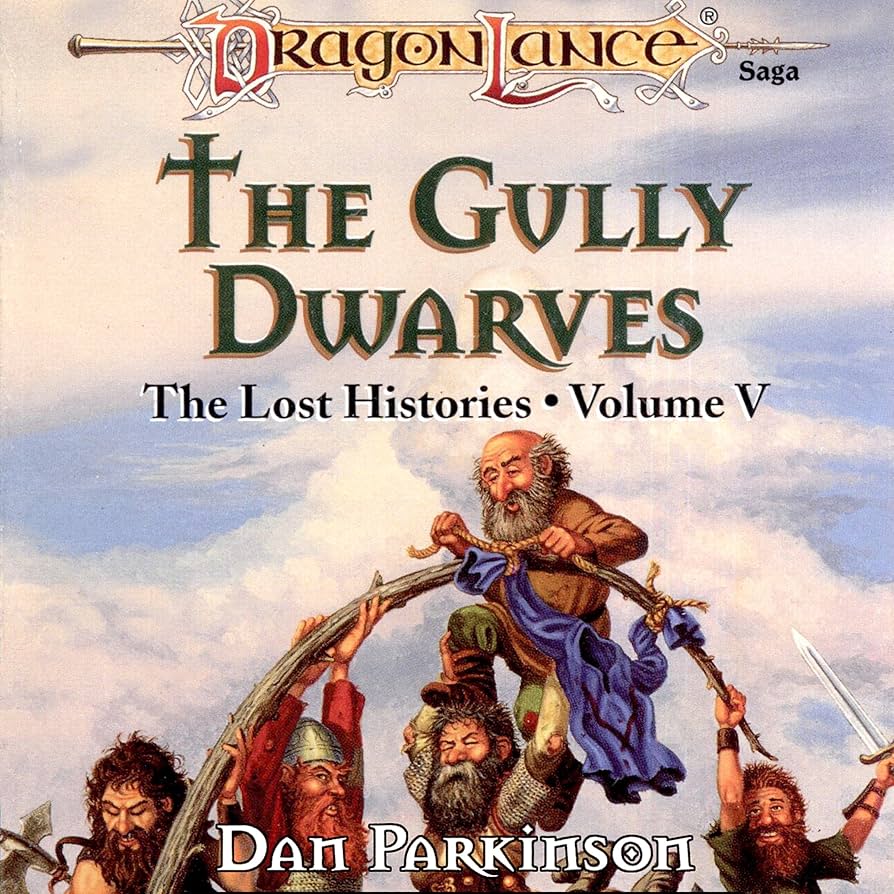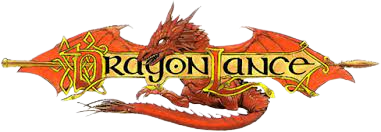The Gully Dwarves

Table of Contents
ToggleOverview
The Gully Dwarves explores the long-neglected and often-ridiculed Aghar, or “gully dwarves,” a race that has traditionally been the comic relief of Dragonlance—clumsy, dirty, barely literate, and generally dismissed by everyone else on Krynn.
But in this book, the Aghar are given their own story, told with heart, wit, and unexpected wisdom. Author Dan Parkinson crafts a tale that combines humor with cultural insight, revealing that behind their buffoonery lies a race that has endured, adapted, and survived through sheer stubbornness and a different kind of cleverness.
Main Character: Rebo
- A clever (by gully dwarf standards) Aghar with a rare gift for remembering things, making him something of a genius among his people.
- Rebo becomes the reluctant “hero” of the story, propelled into action when his tribe’s survival is threatened.
- His journey is both a parody of traditional fantasy quests and a genuine underdog tale of courage, perseverance, and community.
Supporting Characters
- Bulp – Rebo’s dimwitted but loyal companion. Provides comic relief but also heartfelt moments of surprising insight.
- Highbulp Phudge I – The self-proclaimed ruler of all gully dwarves, more interested in titles and status than actual ruling.
- Human and dwarven observers – Outsiders who often underestimate or mistreat the gully dwarves, serving as reflections of wider Krynnish prejudice.
- Ancient enemy forces – Forgotten dangers stirring deep in the ruins where the Aghar dwell, bringing real stakes to the seemingly absurd tale.
Setting
- Primarily set in abandoned ruins, sewer systems, and crumbling cities—the environments where gully dwarves make their homes.
- These places are filthy, dangerous, and ignored by “civilized” races, yet they are where the Aghar have carved out survival over centuries.
- There are also flashbacks and mythic retellings of gully dwarf history, adding surprising richness to their background.
Plot Summary
A Forgotten People
The novel opens by examining the origins of the gully dwarves, who are said to be descended from a mingling of dwarves and goblins, or possibly the result of magical mutation. Whatever their true origin, they have been scorned, displaced, and hunted, surviving in the shadows of society.
Despite this, the Aghar continue to live in their own way—with a childlike innocence, a unique brand of logic, and a remarkable ability to endure.
The Prophecy and the Quest
Rebo, a slightly smarter-than-average Aghar, finds a lost magical artifact and stumbles into a prophecy that may involve saving his people—or dooming them.
Word spreads, and suddenly Rebo is being hailed (or mistaken) as a chosen one, drawing attention from both dangerous enemies and hopeful followers.
Reluctantly, he sets out with a ragtag group of fellow gully dwarves, embarking on a journey through ruined tunnels and forgotten places to reclaim their lost heritage and stop a growing threat beneath the earth.
A World of Prejudice
Throughout their travels, Rebo and his companions are constantly met with mockery and dismissal from other races. Yet, in moments of crisis, the gully dwarves show:
- Resourcefulness
- Community strength
- And a surprising level of cleverness masked by chaos
Rebo, in particular, rises to the occasion—not by becoming something other than Aghar, but by embracing his people’s unique gifts.
The Climax
In a final confrontation deep below the earth, Rebo must make a choice between abandoning his people or leading them. With comic blunders and accidental successes, the gully dwarves save the day—in their own ridiculous but undeniably effective way.
They are still gully dwarves—but now seen in a new light.
Themes
- Perception vs. Reality – The gully dwarves may seem useless, but this book challenges readers to look beyond appearances.
- Cultural Value – Even a marginalized, mocked race has a culture, history, and wisdom all its own.
- Survival Through Adaptation – The Aghar thrive where others fail because of their ability to adapt, not in spite of their perceived foolishness.
- Dignity in Difference – The novel insists that being different doesn’t mean being lesser. There is heroism in the overlooked.
- Satire and Heart – Humor is used to disarm, but also to illuminate. This is a comedy with soul.
Tone & Style
- Lighthearted, irreverent, and whimsical, full of gags, miscommunication, and chaotic charm.
- Also surprisingly poignant, especially in moments where the Aghar confront discrimination and the loss of their place in the world.
- Think Discworld meets The Hobbit—if Bilbo were accidentally heroic and lived in a sewer.
Reception
The Gully Dwarves is praised for:
- Being funny, clever, and unexpectedly touching
- Giving real attention and depth to a race often played entirely for laughs
- Making readers rethink their assumptions about what defines worth in fantasy settings
Some readers note:
- The book’s tone is sillier than other Dragonlance entries, and may not appeal to those seeking high-stakes drama
- The plot is more episodic and character-focused than epic or world-changing
Still, it’s widely appreciated as a refreshing and heartwarming entry in the Lost Histories series.
Final Thoughts
The Gully Dwarves is a charming, hilarious, and quietly profound story that proves even the smallest, dirtiest, and most disrespected race in Krynn has a tale worth telling. It’s a love letter to underdogs everywhere, and a reminder that heroism comes in all shapes, sizes, and smells.
Recommended for:
- Fans of underdog stories, comic fantasy, and cultural redemption arcs
- Readers who want a break from epic wars and gods in favor of something more personal (and weird)
- Anyone who’s ever laughed at a gully dwarf—and now wants to understand them
“We is what we is. But what we is… is enough.”
